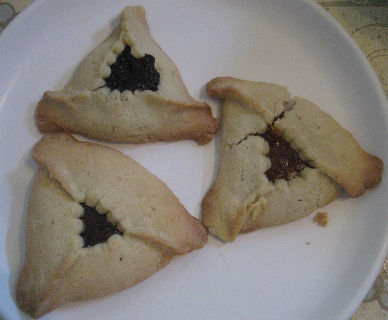Eating Iranian ears would have been so much more fun – if it weren’t for sweet donut memories.
Ah, being Jewish, such a daily philosophical experience! The effort to remind ourselves constantly of the destruction of the temple brings out incessent poetry in our day to day: It’s in our prayers, it’s in our broken-glass weddings, it’s in that corner of the house the observant leave unpainted, it’s even in the cookies.
Take Hamentashen – or Oznei Haman in Hebrew, which literally means “Haman’s ears” – those triangular pastries named for the villain in Purim’s holiday tale. Yes, I know, your grandma used to bake them more delightful and more tender than Parisian macarons. Yes I know, that bakery down on Dizengoff stuffs them with real mascarpone mixed with solid gold and diamonds. Nonetheless, the leap from a holiday in which we eat sufganiot – those irresistible jelly filled donuts of Hanukkah – to one in which we eat a generally dry pastries, traditionally filled with poppy seeds (good when scattered on top of a challa, less appealing as a condensed mush) and named to evoke the severed, dirty ear of an ancient Persian anti-Semite… talk about falling from grace.
These aren’t my thoughts only. As the question went into an online debate on my Facebook page, my friend Cindy, a mother of four living the in the U.S., confirmed: “Prune filling + cookie = more disappointing than getting a toothbrush while trick-or-treating. If we want kids to continue celebrating Jewish holidays we need to come up with more competitive marketing. Christmas and Easter are kicking our asses. They have candy canes and chocolate bunnies, and we get poppy seed and apricot filling? Seriously?” Yup, the key to assimilation is triangle-shaped.
Now, it could be argued that in today’s climate, eating body parts of Iranians is a matter of national security, and that the Hamentashen are simply meant to train us for chewing on Iranian ears once we’ve won the approaching war, since it will leave the entire Middle East wrecked and there will be nothing else to eat.
Another failure, here, since these things look nothing like Iranian ears. Please observe the ear of Leila Hatami, star of Oscar nominated film “Nader and Simin, a Separation,” as it peeks under her headscarf.
Now compare it with the image used to illustrate the Wikipedia article “Hamentashen”.
If anything, I feels as though it is our experience with sufganiot that equips us to consume members of the handsome Persian race, and please consider that they have been eating delicious baklavas and “Gooshefil” for centuries in preparation for eating us.
Of course, the idyll of jelly-filled sufganiot is broken several weeks before Purim with dried figs. The holiday of Tu Bishvat, comfortably situated in between Hanukkah and Purim, is typically celebrated by the eating of dried fruit. The historical excuse for this is as follows: In the Diaspora, Tu Bishvat is a celebration of the land of Israel, and Mediterranean fruit could historically only be delivered to colder countries in their dry form, so we’re stuck with them.
Now, say what you will about dried fruit, they don’t pretend to be yummy cookies. Hamentashen do, and this is unforgivable. The one convincing way to make sense of their appearance on our happiest holiday, is to regard them as a “memento mori” – a reminder of the destruction of Jerusalem. Otherwise, as proposed by +972’s own Haggai Matar, we may simply accept them as a way station on the road to matzos.
(Leila Hatami image taken from http://www.youtube.com/watch?v=_4JYDc5789U)



